Abstract
When the lightning current enters the ground through the grounding system, the impulse dispersion performance can be observed by the phenomenon of soil spark discharge, which is fundamentally determined by the nearby soil. At present, engineers use an empirical formula to convert the soil spark discharge to the impulse coefficient of impulse grounding resistance. Therefore, there is no available quantitative analysis method to evaluate soil impulse dispersion performance. To solve this problem, this paper proposes an evaluation method for the impulse discharge efficiency of soil by using X-ray images, define VI as the parameter, which is the ratio of the volume of the discharge area to the peak current. Then, the rationality and validity of the method are verified. Finally, the variation rules of impulse discharge efficiency are analyzed in different soils. Results show that the VI can reflect the change rules of impulse dispersion performance more clearly under different soil conditions, and this parameter provides a new idea for enhancing the impulse dispersion performance of soil near the grounding electrode.
1. Introduction
Soil is the key to affect the impulse dispersion performance of grounding devices [1]. Especially, spark discharge will occur when the impulse current is injected into the ground electrode, which significantly enhances the impulse dispersion performance of the grounding device [2,3]. Therefore, the accurate evaluation of soil impulse dispersion performance can provide a basis for the selection of soil resistance reduction measures [4].
At present, due to the lack of effective observation methods, it is impossible to carry out accurate quantitative analysis on the real topography of soil discharge area. Reference [5] conducted impulse breakdown experiments on the soil between spherical electrodes by building a cylinder test tank in the laboratory, and the breakdown discharge path of soil was obtained by X-ray film. In [6], the impulse discharge experiment of a suspended electrode on the soil surface was carried out in a hemispherical iron pot with a diameter of 10 cm, and the soil spark discharge channel was recorded by the conductive paper. Reference [7] obtained the actual soil discharge channel through field test excavation. In the above studies, due to the fuzzy measured results, the discharge channels obtained cannot be used as a quantitative index to evaluate the soil impulse dispersion performance.
The impulse dispersion performance of the grounding device is determined by the structure and size of the grounding electrode, the impulse dispersion performance of the soil, and the buried depth of the grounding electrode. However, when the impulse current flows into the ground, the intensity of the instantaneous electric field in the ground near the electrode will exceed the intensity of the soil’s critical breakdown field, and the spark discharge area will appear at the end of the electrode. A large number of experimental studies found that the soil discharge area is affected by the distribution of the electric field in the ground and that soil discharge is unpredictable. The existence of a soil discharge area can greatly improve the impulse dispersion capacity of the soil near the grounding electrode [8,9,10,11,12]. At present, there is still a lack of a visualized index to evaluate the impulse dispersion performance of soil, which is mainly characterized by the critical breakdown field strength and residual resistivity of typical soil, which are not easy to be applied in practical engineering [13,14,15].
However, at present, there is no unified understanding of the mechanism of soil impulse discharge among scholars at home and abroad, and different researchers have proposed a variety of viewpoints on soil impulse discharge based on experimental observations [16]. In reference [17], the characteristics of soil ionization were firstly taken into account in the soil dispersion model, and it was proposed that there is an ionization region around the grounding device under the effect of impulse current, and its structure was considered to be an axisymmetric cylindrical structure about the electrode. Based on the same idea, a hemispherical discharge model was proposed in reference [18]. In reference [19], a cylindrical discharge model was proposed after considering the spatial inhomogeneity of current in the earth. A penetrating X-ray imaging technology was first applied in reference [20] to study the soil ionization under surge current and to calculate the soil residual resistivity of discharge area by a finite-element method, according to experiment parameters and a 3-D diagram of the discharge area. Reference [21] calculated the volume of successive impulse discharge channels in the ground under various currents and soil conditions. It also analyzed the changing law with time intervals based on the gray information analysis method and improved the four-zone model of soil under impulse current. Reference [1] proposed a four-zone soil discharge model. In the process of impulse dispersion, the soil’s electric field intensity near the grounding pole gradually decreases outward, which can be divided into four regions: arc region, spark discharge region, semiconductor region, and constant conductivity region. The above soil impulse discharge models are all based on the assumption that soil is isotropic. However, soil is a polymorphic composite medium containing solid soil particles, liquid water, and air. Therefore, ignoring the influence of anisotropy of the soil on the impulse discharge process will be different from the actual situation. Reference [7] found that the actual soil discharge area was different from the above hypothesis through field experiment excavation, but was a channel structure with fewer branches. It can be seen that when the impulse current is injected into the soil, the intensity of the soil’s electric field at the end of the grounding will exceed the intensity of the critical breakdown field of the soil, and a concentrated discharge area will be generated, forming a breakdown channel structure.
In summary, there is still a lack of suitable quantitative methods to evaluate the soil impulse dispersion performance in the near-ground area according to the data from various sources. To solve this problem, based on the image observation of soil spark discharge [8,9], a quantitative evaluation index was proposed to combine the discharge area and impulse current amplitude of soil samples. The rationality and effectiveness of the method are verified, and the variation law of the impulse dispersion performance of grounding devices is analyzed in soil samples with different properties. This method can quantitatively evaluate the impulse dispersion performance of the soil near the ground electrode, which provides a new idea for enhancing the impulse dispersion capability of the soil near the ground electrode.
2. Theoretical Derivation of Characteristic Quantity of Soil Impulse Dispersion Performance
Generally, the common grounding device of transmission line towers consists of horizontal or vertical ground electrodes [22,23,24]. Taking the vertical electrode structure as an example, the process of soil dispersion is analyzed theoretically. In Figure 1, the radius of the ground electrode is r0, the length is l, and it is buried in the ground vertically. The soil resistivity is ρ, and the soil discharge area is a slender cylindrical channel with a bottom radius of r’, a length of l’, and a current of I, which flows into the medium through the rod. In this paper, a mirror electrode and discharge region with a length of (l + l’) are assumed under the ground by means of mirroring, and the semi-infinite space in the calculation of the current field is transformed into infinite space.
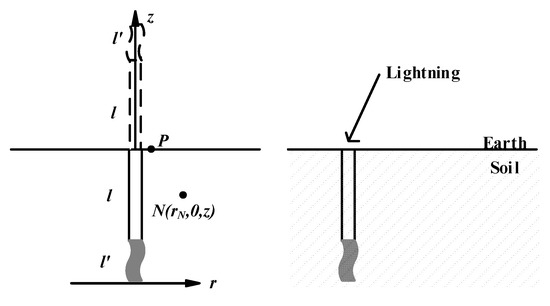
Figure 1.
A round rod-shaped ground electrode embedded in the ground vertically.
When no discharge occurs in the soil, assuming that the current density is δ at any point in the soil, the potential of N (rN, 0, z) at any point is
If the electrode potential u is equal to the potential up on the surface of the midpoint along the electrode length, that is zN = l, rN = r0, then the electrode potential is:
The grounding resistance of the ground electrode in the semi-infinite medium is:
When soil discharge occurs, the residual resistivity drops to about 0.003, 62% of the initial soil resistivity [8], which is close to the metal resistivity. The grounding resistance of the ground electrode is:
Grounding resistance is reduced by ΔR:
According to (5), the reduction of ground resistance is related to the volume parameter of the area where soil ionization occurs. If the length of the ground electrode is 2.5 m, the section radius is 4 mm, the length of the breakdown area is 0.5 m, and the radius r’ = 2r0, then ΔR ≈ 0.145R, and the grounding resistance of ground electrodes is reduced by 14.5%. It can be seen that the soil impulse diffusivity is an important factor affecting the diffusivity of the ground electrode.
A larger discharge area leads to a more intense soil discharge process, which promotes the release of lightning energy in the soil [25,26,27]. Moreover, the volume of the discharge area increases with the rise of impulse current. VI defined as the equivalent value of soil discharge volume per unit electric current, that is:
where, V is the volume of the soil impulse discharge area, cm3; I is the amplitude of the ground current, kA.
A small value of VI indicates that there is a space to further improve the impulse dispersion performance of the ground electrode by modifying soil. Therefore, the parameters can reflect the impulse dispersion performance of grounding device directly and clearly.
3. Test Method of Soil Impulse Dispersion near the Area of Ground Electrode
From the above analysis, it can be seen that it is necessary to put forward a method to obtain the specific structural parameters of the soil discharge area. The soil impulse discharge observation platform is shown in Figure 2. The impulse current is generated and applied to the ground electrode and recorded by oscilloscope. Then, an X-ray imaging system was used to image the discharge area in the soil; finally, the spatial structure of the soil discharge area is obtained by image processing.
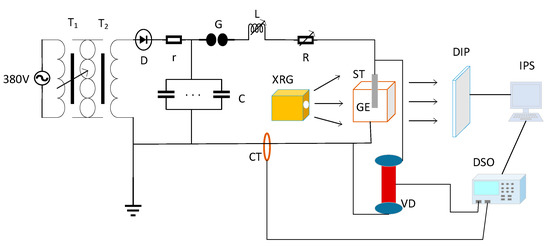
Figure 2.
Sketch of the impulse current test setup: T1: Voltage regulator; T2: Voltage booster; D: Rectifier; r: Protective resistance; C: Charging capacitor bank; G: Sphere gap; L: Wave modulated inductance; R: Wave modulated resistance; XRG: X-ray generator; CT: Electric current transducer; ST: Sample sandbox; GE: Grounding electrode; VD: Voltage divider; DIP: Digital imaging plate; DSO: Oscilloscope; IPS: Image processing system.
In the experiment, glass fiber was prepared with a side length of 0.2 m and a thickness of 0.01 m. The cylindrical vertical ground electrode was selected with a diameter of 0.0025 m and a length of 0.15 m. Besides, the distance is 0.1 m between the electrode bottom and the sides of the test groove. The conductive copper foil is embedded in the inside of the test groove as the ground electrode, and the distances are equal between the ground electrode terminal and each side of the copper foil.
According to the image of the soil spark discharge area, the three-dimensional (3D) reconstruction algorithm of two-stage stretching is adopted to obtain the 3D structure of the soil discharge area [28,29]. According to the soil sample discharge image, the volume of soil spark discharge area was calculated using the method given above, and the value of VI of soil sample discharge area could be calculated according to (6). The measured value of ground resistance Rch1 can be obtained by calculating the current and voltage waveform recorded by the oscilloscope.
4. Study on the Validity of the Paper’s Method and the Main Influence Factors
It can be seen from the above analysis that it is feasible to use the equivalent value, which represents soil discharge volume per unit electric current (VI), to describe the evaluation index of the near-area soil impulse dispersion ability. In order to further verify its validity and rationality, this paper carried out a comparative experiment on the near-area soil dispersal capacity.
4.1. The Validity Analysis of the Method for Evaluating the Near-Area Soil Impulse Dispersion Capacity
In actual engineering, the empirical formula is used by translating the soil spark discharge effect into the impulse coefficient of grounding device, as shown in Equation (7):
where: R is the power frequency grounding resistance of the grounding device; α is the impulse coefficient, and the range is 0.5~3. In engineering, α is usually based on the geometric size of the grounding electrode, soil resistivity, and other parameters, which are set as 0.85 [1] in this paper.
In order to verify the effectiveness of soil discharge volume per unit electric current (VI) as an evaluation index of the dispersion capacity of grounding device, this paper carried out a comparative test study on the near-area soil dispersion capacity. First of all, by adding super absorbent polymer (SAP) and regulating soil water content, soil samples with a resistivity of 50 Ω·m and different moisture content were prepared [30,31,32]. Then, an impulse current with an amplitude of 2.0 kA was applied to the soil samples. The image of the soil discharge channel could be obtained by X-ray projection imaging technology, and the structural parameters of the soil discharge area could be calculated by using the three-dimensional reconstruction method. Finally, the value of VI of the soil sample’s discharge area can be calculated by using Equation (6), combining the amplitude of measured impulse current. At the same time, the oscilloscope can be used to record the current and voltage waveform on the grounding conductor, so as to obtain the measured value of the impulse grounding resistance Rch. Formula (7) can be used to calculate the value of empirical impulse grounding resistance R’ch.
The images obtained in the experiment are shown in Figure 3, and the impulse current and voltage waveform on the grounding conductor are shown in Figure 4. VI, R’ch, Rch are shown in Table 1.

Figure 3.
Images of soil with the same resistivity and different water content: (a) The moisture is 23.56%; (b) moisture is 39.14%; (c) moisture is 40.50%; (d) moisture is 48.80%.
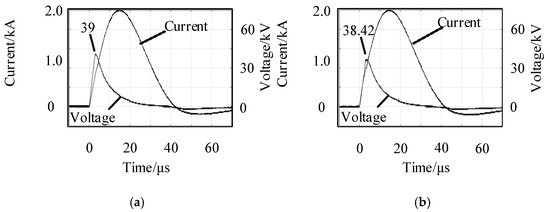
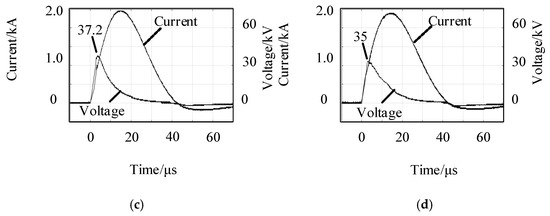
Figure 4.
Current and voltage waveform of soil with the same resistivity and different water content: (a) The moisture is 23.56%; (b) moisture is 39.14%; (c) moisture is 40.50%; (d) moisture is 48.80%.

Table 1.
VI and Rch2 of soil with the same resistivity that is 50 Ω·m and different water content.
The moisture in Table 1 was determined by the experimental measurements, and four typical results were chosen from the experiment due to space constraints. Since that the soil resistivity of the soil sample, the grounding resistance R, and the impulse coefficient values α of Formula (7) do not change, the calculated value of the impulse grounding resistance Rch2 does not change, while the measured grounding electrode’s impulse grounding resistance Rch1 decreases slightly, this is because the impulse current applied in every soil sample was the same, but only the impulse voltage showed a slight difference, which were 39 kV, 38.42 kV, 37.2 kV, and 35 kV, respectively. This also results in very little difference in the values of Rch1 calculated in Table 1, but the VI of the discharge area of the soil sample increases greatly. As can be seen, there was a large change in resistance when the soil moisture only changed by 1.36%, which means that when the moisture of the sample chosen was near this value, the change of impulse grounding resistance was more sensitive, and a small change of water content would cause a large change of impulse grounding resistance. The change of impulse grounding resistance was very slow before this value, so it showed that with the increase in water content, the impulse grounding resistance changed more and more obvious, and the value of VI showed the same rule, which proved that the conclusion is correct and that VI has a certain correlation with the impulse grounding resistance. The results also showed that VI is better than the impulse grounding resistance when we evaluate the impulse dispersion performance of the grounding device because VI is more obvious than the impulse grounding resistance calculated by the waveform recorded. Therefore, compared with the empirical formula calculation method commonly used in engineering, the VI ’s value, which is based on the image characteristics of soil impulse dispersion, can more clearly indicate the influence of the change of soil medium properties and describe the impulse dispersion capacity of the grounding equipment in the process of impulse dispersion.
4.2. Correlation Analysis between VI and Rch
This paper also carried out the correlation analysis between VI and impulse grounding resistance Rch. According to the analysis above, there is a negative correlation between the two parameters. In order to facilitate the analysis, the correlation between the reciprocal of the impulse grounding resistance and VI of the grounding device is analyzed.
In this paper, soil samples with a resistivity of 100, 300, 500, 700, and 1000 Ω·m are selected, which are impinged a current of 2.0 kA to carry out the comparative test of near area soil dispersal capacity. Some images obtained from the test are shown in Figure 5, the impulse current and the impulse voltage waveform on the grounding conductor are shown in Figure 6, and the variation rule of VI and Rch’s reciprocal is shown in Figure 7.
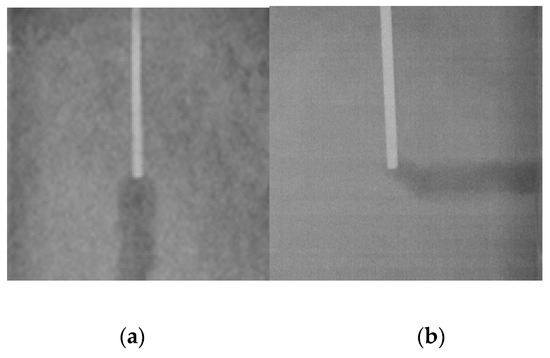
Figure 5.
Image of the soil discharge channel of different soil resistivity: (a) ρ = 300 Ω·m; (b) ρ = 700 Ω·m.
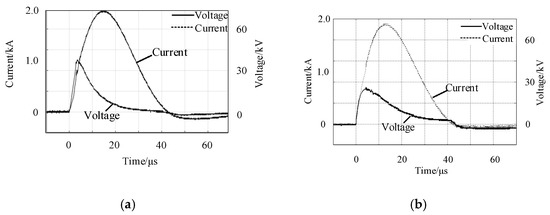
Figure 6.
Current and voltage waveform of soil of different soil resistivity when injected into impulse current: (a) ρ = 300 Ω·m; (b) 700 Ω·m.

Figure 7.
VI and reciprocal of Rch of different soil resistivity.
As can be seen from Figure 7, The change rule of the equivalent value of the soil discharge volume per unit electric current is the same as that of the reciprocal of the grounding resistance of the grounding electrode. The calculated correlation coefficient r is shown in Table 2.

Table 2.
VI and reciprocal of Rch of different soil resistivity.
According to Table 2, under different soil resistivity, the correlation coefficient r of VI and Rch’s reciprocal is above 0.9, showing a significant correlation. Therefore, the evaluation method of the near-area soil impulse dispersion performance proposed in this paper can directly depict the impulse dispersion performance of soil media, it is proved to be feasible and effective enough to enrich the evaluation system of the impulse dispersion ability of a grounding device, complementing the evaluation method of the soil impulse dispersion performance.
4.3. Variation of VI with the Content of SAP
In order to compare and analyze the change of the volume of the modified soil discharge area under the equivalent unit current under different content of SAP, soil moisture content was controlled to be 5% and soil density was controlled to be 1.25 g/cm3. Modified soils with a content of SAP of 0%, 0.1%, 0.25%, and 0.5% were prepared, respectively. The amplitude of the impulse current was 2.0 kA when the ground electrode in the soil modified by SAP was injected. Figure 8, Figure 9, Figure 10 and Figure 11 show the topography of the discharge area obtained during the impact diffuser test, the impulse current and impulse voltage waveforms flowing through the modified soil are shown in Figure 12, Figure 13, Figure 14 and Figure 15.

Figure 8.
Image of the soil discharge channel before modification: (a) Before breakdown; (b) front view; (c) side view; (d) top view.

Figure 9.
Images of modified soil with the SAP content of 0.1%: (a) Before breakdown; (b) front view; (c) side view; (d) top view.

Figure 10.
Images of modified soil with the SAP content of 0.25%: (a) Before breakdown; (b) front view; (c) side view; (d) top view.

Figure 11.
Images of modified soil with the SAP content of 0.5%: (a) Before breakdown; (b) front view; (c) side view; (d) top view.
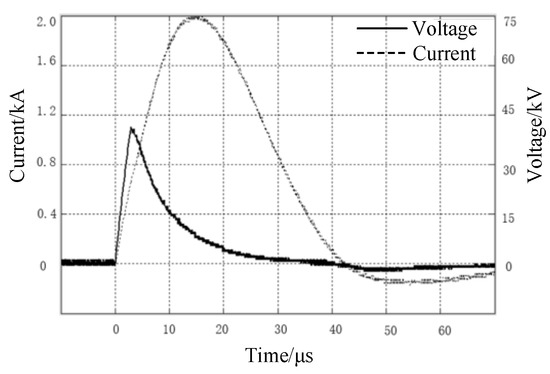
Figure 12.
Current and voltage waveform of soil without SAP when injected into the impulse current.
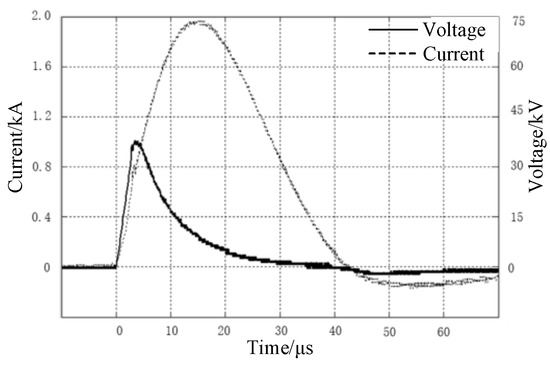
Figure 13.
Current and voltage waveform of modified soil with the SAP content of 0.1% when injected into the impulse current.
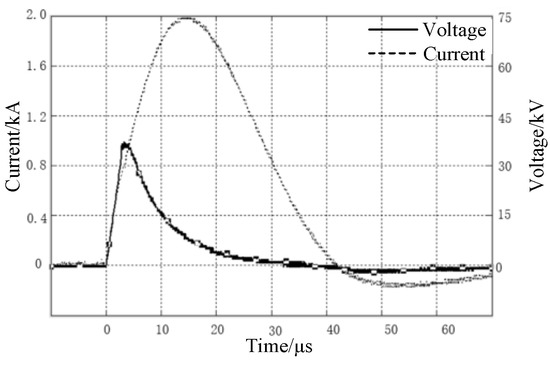
Figure 14.
Current and voltage waveform of modified soil with the SAP content of 0.25% when injected into the impulse current.
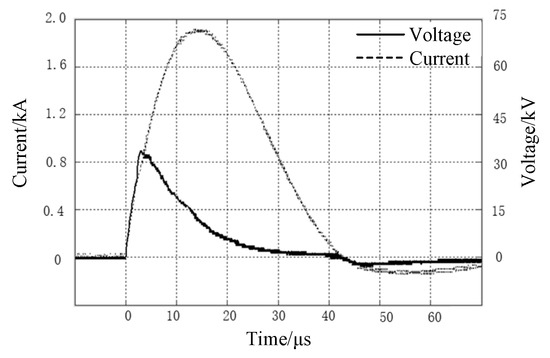
Figure 15.
Current and voltage waveform of modified soil with the SAP content of 0.5% when injected into the impulse current.
Figure 16 shows that with the increase in the content of SAP in the soil, the impulse grounding resistance of the soil decreases slightly, and the value of VI in the soil discharge area increases gradually. SAP changes the ratio of solid, liquid, and gas in the soil, and it reduces the resistivity of the soil dispersion area, so it makes the soil discharge process more intense, which is macroscopically represented by the increase in the volume of the discharge area. When the SAP ’s content was 0.5%, the value of VI of the dispersion zone in the modified soil was 24.59 cm3/kA. Compared with the modified soil without SAP, the value of impulse grounding resistance decreased by 10.26%, and the value of VI increased by 3.54 times. Compared with the impulse grounding resistance’s value of the grounding electrode, the change of the value of VI of the soil is more obvious, and it is less affected by the test conditions. Therefore, in areas with high soil resistivity, when SAP is used to modify the soil near the grounding electrode, the long-term effectiveness of SAP’s resistance reduction performance can be monitored based on the size of VI’s value.
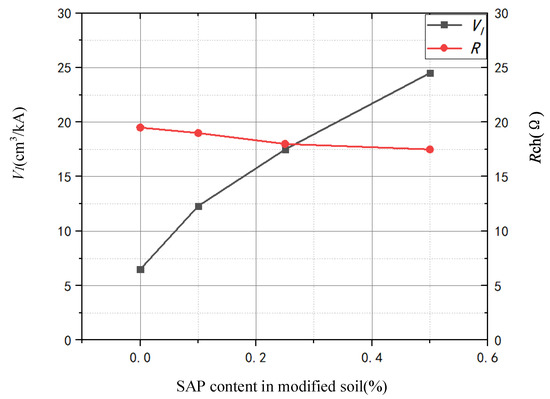
Figure 16.
Curve of VI with the content of SAP.
4.4. Variation of VI with Water Content of Modified Soil
In order to compare and analyze the dispersion efficiency of the soil near the grounding conductor under different water contents, this paper selects the modified soil with different water contents to carry out the comparative test of the dispersion efficiency of the soil near the grounding electrode. Keeping the mass ratio of the modified material to the unmodified soil equal to 5:1000 and the soil density equal to 1.25 g/cm3, the water content of the modified soil was adjusted to 10%, 15%, and 25%, respectively. The amplitude of the impulse current is 2.0 kA when the ground electrode of modified soil is injected. Figure 17, Figure 18 and Figure 19 show the morphologic characteristics of the discharge area obtained during the impulse dispersion test process. Figure 20, Figure 21 and Figure 22 show the impulse current and impulse voltage waveform when the current flows through the modified soil.

Figure 17.
Images of modified soil with water content of 10%: (a) Before breakdown; (b) front view; (c) side view; (d) top view.

Figure 18.
Images of modified soil with water content of 15%: (a) Before breakdown; (b) front view; (c) side view; (d) top view.

Figure 19.
Images of modified soil with water content of 25%: (a) Before breakdown; (b) front view; (c) side view; (d) top view.
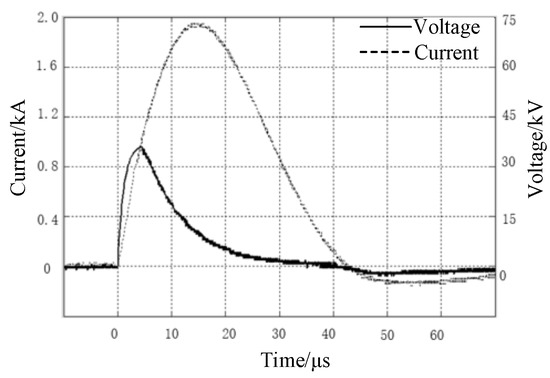
Figure 20.
Current and voltage waveform of modified soil with the water content of 10% when injected into the impulse current
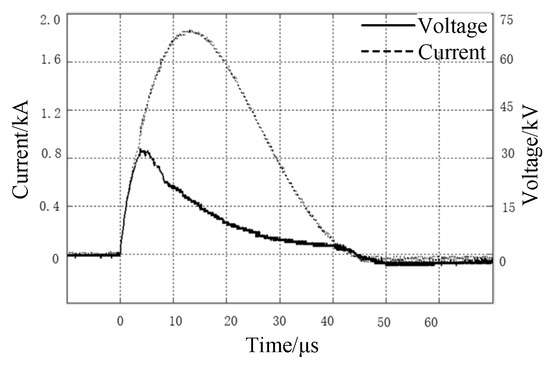
Figure 21.
Current and voltage waveform of modified soil with the water content of 15% when injected into the impulse current.
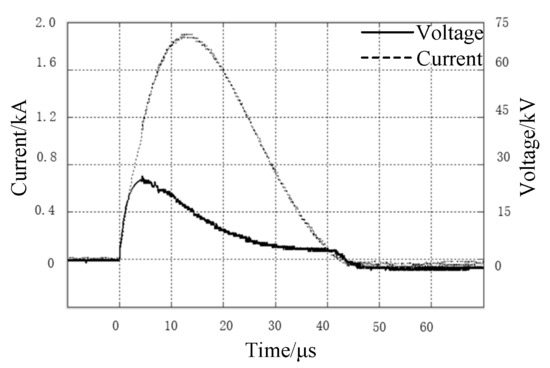
Figure 22.
Current and voltage waveform of modified soil with the water content of 25% when injected into the impulse current.
As can be seen from Figure 23, with the change of water content in the modified soil, the value of VI in the spark discharge area in the modified soil increases, and the value of impulse grounding resistance of the grounding electrode gradually decreases, indicating that the dispersion performance of the modified soil is also continuously enhanced. In addition, when the moisture content of the modified soil was 25%, VI was 20.10 A/cm3, which decreased by about 55.47% compared with that of 5%. This indicates that modified soil with higher moisture brings a discharge process with greater intensity and a better dispersion capacity of the impulse current. This is because SAP absorbs sufficient water in the modified soil, and a large number of water molecules fill the air gap between the soil particles, which reduces the resistivity of the modified soil near the grounding electrode. At the same time, with the increase in moisture in the soil, water film appears on the contact surface between the grounding conductor and the soil, which reduces the contact resistance, and the soil discharge process becomes more intense, which is macroscopically represented by the increase in the volume of the soil discharge area.
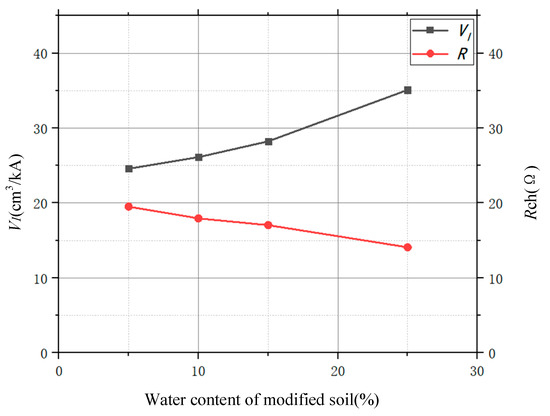
Figure 23.
Curve of VI with water content of modified soil.
5. Conclusions
In this paper, X-ray imaging technology is used to observe the discharge area in the soil, and the equivalent value of the discharge volume of the soil per unit electric current (VI) is proposed as an index to evaluate the soil impulse dispersion performance in the near-area of the grounding device. The feasibility and effectiveness of the method were verified by the simulation test, and the variation law of impulse dispersal capacity of soil samples with different properties was analyzed. Specific conclusions are as follows:
- The proposed equivalent value of soil discharge volume per unit electric current, combined with the image characteristics of soil impulse discharge, can directly reflect the dispersion of the impulse current in the soil, and the results of the evaluation can reflect the change law more significantly than the results calculated by an empirical formula and measurement waveform. However, the limitation is that other types of soil and soil heterogeneity are not considered.
- The experimental results show that when the samples’ soil resistivity is the same and the soil moisture content is different, the VI of the soil medium is different, and increases with the increase of the moisture content, but the value of the empirical formula recommended by the regulations remains unchanged.
- In the area of high soil resistivity, when the VI ’s value is small, it indicates that there is space to further improve the impulse dispersion performance of the grounding electrode by modifying the soil.
- With the increase in the content of SAP, the VI of the discharge zone of the soil increased gradually. When the content of the modified material was 0.5%, the VI’s value of the dispersion zone of the soil modified by SAP was 24.59 cm3/kA. Compared with the modified soil without SAP, the impulse grounding resistance decreased by 10.26%, and the value of VI increased by 3.54 times.
- With the increase in moisture content of the soil modified by SAP, the discharge process of soil becomes more intense, and the impulse dispersion performance is better. In the soil modified by SAP, VI is 20.10 cm3/kA when the water content is 25%. Compared with the modified soil with 5% water content, VI increases by about 55.47%.
In this article, the sand was the only test sample to be modified, and then this paper explored the impulse dispersion performance of modified soil. Therefore, in the future, the modification of other types of soil is expected to be carried out to study their VI characteristics, such as gravel soil, clay soil, frozen soil, etc. In addition, the experimental platform is going to be updated to increase the amplitude of the impulse current, to permit double impulse current, and to increase the size of soil samples, so as to study whether the change rule of VI’s value under the uneven soil model is still applicable. Finally, on the basis of all the research, the evaluation method of the impulse dispersion performance of various existing grounding resistance reduction materials and resistance reduction schemes will be studied, so as to select the most effective resistance reduction measurement to minimize the grounding resistance in high soil resistivity areas and provide a safer grounding environment.
Author Contributions
Investigation, X.H.; methodology, X.Z. and G.B.; project administration, D.L., Y.Z. and Y.C. All authors have read and agreed to the published version of the manuscript.
Funding
This work is supported by the Science and Technology Project of State Grid Corporation of China (“Study on the Transient Characteristics of Grounding System and the Test and Evaluation Method of Current Dispersion Performance Under the Successive Impulse Current”, 5500-202026088A-0-0-00).
Institutional Review Board Statement
Not applicable.
Informed Consent Statement
Not applicable.
Data Availability Statement
The study did not report any data.
Acknowledgments
Thank Xiejun Du and Xiaochuan Li for their advice and help in the process of paper.
Conflicts of Interest
The authors declare no conflict of interest.
References
- He, J.L.; Zeng, R. Power System Grounding Technology; Science Press: Beijing, China, 2007; pp. 130–137. [Google Scholar]
- Yuan, T.; Li, T.X.; Sima, W.X.; Liu, S.W.; Luo, D.H.; Li, X.C. Analysis of soil discharge image characteristics under impulse currents. Proc. CSEE 2018, 38, 5266–5274. [Google Scholar]
- Chen, M.M.; Cao, X.B.; Yang, L.; Wu, H.; Zhang, M.; Wu, G.N. Experimental study on soil impulse characteristics surrounding Coaxial cylindrical electrode. Power Syst. Technol. 2013, 37, 2291–2296. [Google Scholar]
- Yuan, T.; Ban, G.G.; Luo, D.H.; Li, J.L.; Zhang, X.; Zuo, S.J. Evaluation Method of Impulse Discharge Performance of Ground Electrode Based on Soil discharge Image. In Proceedings of the 2020 IEEE International Conference on High-Voltage Engineering (ICHVE 2020), Beijing, China, 6–10 September 2020. [Google Scholar]
- Gao, Y.Q. Study on Soil Impulse Breakdown Mechanism and Transient Characteristics of Grounding System. Ph.D. Thesis, Tsinghua University, Beijing, China, 2003. [Google Scholar]
- Wang, J.P.; Liew, A.C.; Darveniza, M. Extension of dynamic model of impulse behavior of concentrated grounds at high currents. IEEE Trans. Power Delivery 2005, 20, 2160–2166. [Google Scholar] [CrossRef]
- Rakov, V.A. Triggered Lightning; Springer: Berlin, Germany, 2009. [Google Scholar]
- Liu, S.W. Study on X-ray Digital Image Characteristics of Soil Impulse Discharge and Transient Performance of Grounding Device. Ph.D. Thesis, Chongqing University, Chongqing, China, 2017. [Google Scholar]
- Feng, Z.Q. Study on the Impulse Characteristics of the Grounding Devices and the Morphology Features of the Soil Sparkover. Ph.D. Thesis, Wuhan University, Wuhan, Hubei, China, 2016. [Google Scholar]
- Zhu, B.; Sima, W.X.; Yuan, T. Structure parameter optimization of grounding device with needle-shaped conductors based electric field distribution in soil. Power Syst. Technol. 2015, 39, 2907–2914. [Google Scholar]
- Li, J.L.; Jiang, J.D.; Li, L.L. Simulation and experiment study on resistance-reducing mechanism of grounding device with spicules. Power Syst. Technol. 2013, 37, 211–217. [Google Scholar]
- He, J.L.; Zhang, B. Progress in Lightning Impulse Characteristics of Grounding Electrodes with Soil Ionization. IEEE Trans. Ind. Appl. 2015, 51, 4924–4933. [Google Scholar] [CrossRef]
- Yang, L.; Wu, G.N.; Tian, X.F. Analysis of impulse characteristic grounding electrode in frequency and time domain based on EMTP. Trans. China Electrotech. Soc. 2011, 26, 194–198. [Google Scholar]
- Jose, C.; Antonio, F.O.; Carlos, G. Nodal frequency analysis of grounding systems considering the soil ionization effect. IEEE Trans. Power Deliv. 2000, 15, 103–107. [Google Scholar]
- Lu, H.L.; Feng, Z.Q.; Wen, X.S. Full-time electrical network model of the transient characteristics of the grounding devices considering soil sparkover. Proc. CSEE 2017, 37, 7058–7065+7098. [Google Scholar]
- Neknoul, B.; Labie, P.; Zgainski, F.X.; Meunier, G. Caculating the impedance of the grounding system. IEEE Trans. Nucl. Sci. 1996, 32, 1509–1512. [Google Scholar]
- Snowden, D.P.; Erler, J.W. Initiation of electrical breakdown of soil by water vaporization. IEEE Trans. Nucl. Sci. 1983, 30, 4568–4571. [Google Scholar] [CrossRef]
- Bellaschi, P.L.; Armington, R.E. Impulse and 60-cycle characteristics of driven grounds—Ill. effect of lead in ground installation. Trans. Am. Inst. Electr. Eng. 1943, 62, 334–345. [Google Scholar] [CrossRef]
- Liew, A.C.; Darveniza, M. Dynamic model of impulse characteristics of concentrated earths. Electr. Eng. Proc. Inst. 1974, 121, 123–135. [Google Scholar] [CrossRef]
- Sima, W.X.; Liu, S.W.; Yuan, T.; Luo, D.H.; Wu, P.; Zhu, B. Experimental study of the discharge area of soil breakdown under surge current using X-ray imaging technology. IEEE Trans. Ind. Appl. 2015, 51, 5343–5351. [Google Scholar] [CrossRef]
- Luo, D.H.; Cao, Y.X.; Zhang, Y.; Xie, S.J.; Zhang, C.M.; Cao, S.P. Study on Structural Parameters and Analysis Method of Soil Successive Impulse Discharge Channel. Energies 2021, 14, 877. [Google Scholar] [CrossRef]
- Radakovic, Z.R.; Kostic, M.B. Behaviour of grounding loop with bentonite during a ground fault at an overhead line tower. IEEE Trans. Gener. Transm. Distrib. 2001, 148, 275–279. [Google Scholar] [CrossRef]
- Bellaschi, P.L. Impulse and 60-Cycle Characteristics of Driven Grounds. Trans. Am. Inst. Electr. Eng. 1941, 60, 123–128. [Google Scholar] [CrossRef]
- Zhu, S.Y.; Yuan, T.; Zhu, B. Finite element model of impulse dispersing characteristics of grounding equipment in layered soil. Power Syst. Technol. 2014, 38, 2304–2309. [Google Scholar]
- Guo, Z.H.; Xing, T.F.; Wu, G.N. Grounding resistance change rule of vertical grounding electrode in frozen soil. High Volt. Eng. 2014, 40, 698–706. [Google Scholar]
- Wang, J.J.; He, J.L.; Zou, J. Influence of seasonal frozen soil layer on current division factor of substation grounding system. Power Syst. Technol. 2006, 30, 41–45. [Google Scholar]
- Chen, X.L.; Huang, Y.; Zhang, J.Y. Caculation formula of impulse grounding resistance for grounding device of power transmission tower. Power Syst. Technol. 1996, 20, 9–12. [Google Scholar]
- Li, T.X. Study on Grounding Resistance Reduction Performance of Super Absorbent Polymer Material. Ph.D. Thesis, Chongqing University, Chongqing, China, 2018. [Google Scholar]
- Xiao, Y.M. Preliminary study of standard system construction of new medical imaging devices. China Med. Device Inf. 2015, 21, 41–44+47. [Google Scholar]
- Yamane, H.; Ideguchi, T.; Tokuda, M. Stability against temperature and environment for ground resistance reducing material using watered absorbent polymer. Electron. Commun. 1994, 77, 100–110. [Google Scholar]
- Yamane, H.; Ideguchi, T.; Tokuda, M. A new ground resistance reducing material based on water-absorbent polymer. Electron. Commun. 2010, 77, 68–78. [Google Scholar] [CrossRef]
- Khan, Y.; Malik, N.H.; Arainy, A.A. Efficient use of low resistivity material for grounding resistance reduction in high soil resistivity areas. In Proceedings of the Tencon IEEE Region 10 Conference, Fukuok, Japan, 21–24 November 2011. [Google Scholar]
Publisher’s Note: MDPI stays neutral with regard to jurisdictional claims in published maps and institutional affiliations. |
© 2021 by the authors. Licensee MDPI, Basel, Switzerland. This article is an open access article distributed under the terms and conditions of the Creative Commons Attribution (CC BY) license (https://creativecommons.org/licenses/by/4.0/).